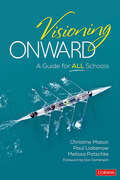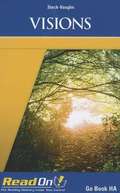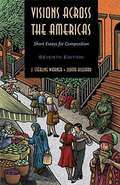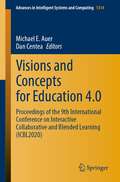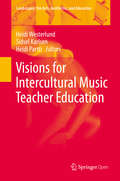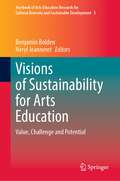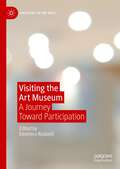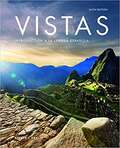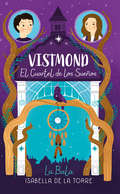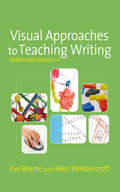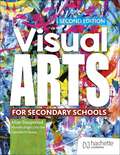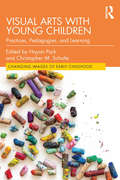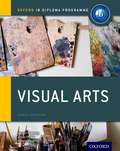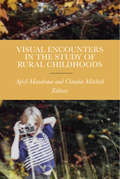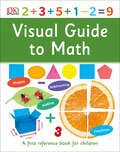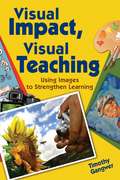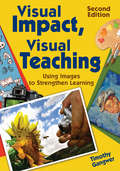- Table View
- List View
Visioning Onward: A Guide for All Schools
by Paul W. Liabenow Christine Y. Mason Melissa D. PatschkeThe step-by-step guide to defining your vision—and making it reality As a leader, it’s your job to look beyond the present and envision a brighter future for your school. Choosing the right path, however, can be a challenge. This inspirational resource is your guide. By following its one-of-a-kind iterative visioning process, you’ll sharpen your vision into a road map for transformative change—tailored to the needs of your learning community. Features include: Key strategies and tools for building a shared vision Practical implementation ideas Case studies from exemplary schools Common trends at the heart of impactful, positive change Thought-provoking vignettes Turn vision into reality, possibilities into plans, and create an environment that strengthens engagement, provides safe and nurturing learning opportunities, and produces students with the skills, knowledge, and disposition to be successful in life.
Visions (Read On! Go Book HA)
by Harcourt Achieve20 short stories designed to increase reading comprehension.
Visions Across the Americas: Short Essays for Composition, 7th Edition
by J. Sterling Warner Judith HilliardVISIONS ACROSS AMERICAS is a good fit for developmental writing courses that focus on essay-level writing. This text is also appropriate for some freshman composition programs.
Visions and Concepts for Education 4.0: Proceedings of the 9th International Conference on Interactive Collaborative and Blended Learning (ICBL2020) (Advances in Intelligent Systems and Computing #1314)
by Michael E. Auer Dan CenteaThis book contains papers in the fields of Interactive, Collaborative, and Blended Learning; Technology-Supported Learning; Education 4.0; Pedagogical and Psychological Issues. With growing calls for affordable and quality education worldwide, we are currently witnessing a significant transformation in the development of post-secondary education and pedagogical practices. Higher education is undergoing innovative transformations to respond to our urgent needs. The change is hastened by the global pandemic that is currently underway. The 9th International Conference on Interactive, Collaborative, and Blended Learning: Visions and Concepts for Education 4.0 was conducted in an online format at McMaster University, Canada, from 14th to 15th October 2020, to deliberate and share the innovations and strategies. This conference’s main objectives were to discuss guidelines and new concepts for engineering education in higher education institutions, including emerging technologies in learning; to debate new conference format in worldwide pandemic and post-pandemic conditions; and to discuss new technology-based tools and resources that drive the education in non-traditional ways such as Education 4.0. Since its beginning in 2007, this conference is devoted to new learning approaches with a focus on applications and experiences in the fields of interactive, collaborative, and blended learning and related new technologies. Currently, the ICBL conferences are forums to exchange recent trends, research findings, and disseminate practical experiences in collaborative and blended learning, and engineering pedagogy. The conference bridges the gap between ‘pure’ scientific research and the everyday work of educators. Interested readership includes policymakers, academics, educators, researchers in pedagogy and learning theory, school teachers, industry-centric educators, continuing education practitioners, etc.
Visions for Intercultural Music Teacher Education (Landscapes: the Arts, Aesthetics, and Education #26)
by Heidi Westerlund Sidsel Karlsen Heidi ParttiThis open access book highlights the importance of visions of alternative futures in music teacher education in a time of increasing societal complexity due to increased diversity. There are policies at every level to counter prejudice, increase opportunities, reduce inequalities, stimulate change in educational systems, and prevent and counter polarization. Foregrounding the intimate connections between music, society and education, this book suggests ways that music teacher education might be an arena for the reflexive contestation of traditions, hierarchies, practices and structures. The visions for intercultural music teacher education offered in this book arise from a variety of practical projects, intercultural collaborations, and cross-national work conducted in music teacher education. The chapters open up new horizons for understanding the tension-fields and possible discomfort that music teacher educators face when becoming change agents. They highlight the importance of collaborations, resilience and perseverance when enacting visions on the program level of higher education institutions, and the need for change in re-imagining music teacher education programs.
Visions of Schooling: Conscience, Community, and Common Education
by Rosemary C. Salomone"In this book, Rosemary Salomone sets aside the ideological and inflammatory rhetoric that surrounds today's debates over educational values and family choice. She offers instead a fair-minded examination of education for democratic citizenship in a society that values freedom of conscience and religious pluralism. And she proposes a balanced course of action that redefines but does not sever the relationship between education and the state. "--BOOK JACKET. Title Summary field provided by Blackwell North America, Inc. All Rights Reserved
Visions of Sustainability for Arts Education: Value, Challenge and Potential (Yearbook of Arts Education Research for Cultural Diversity and Sustainable Development #3)
by Benjamin Bolden Neryl JeanneretThis book stems from the 2019 meeting of the UNESCO UNITWIN international network for Arts Education Research for Cultural Diversity and Sustainable Development. It presents scholarly, international perspectives on issues surrounding arts education and sustainability that addresses the following questions: What value can the arts add to the education of citizens of the 21st century?; What are the challenges and ways forward to realize the potential of arts education in diverse contexts? The book discusses empirical research and exemplary practices in the arts and arts education around the world, presenting sound theoretical and methodological frames and approaches. It identifies policy implications at national, regional and global levels that cut across social, economic, environmental and cultural dimensions of sustainable development.
Visiting the Art Museum: A Journey Toward Participation (Sociology of the Arts)
by Eleonora RedaelliVisiting the Art Museum: A Journey Toward Participation is a book about the visitor experience. It is written as a companion for visitors to and inside the art museum. The volume engages readers in transforming a common experience, the museum visit, into a sophisticated epistemological inquiry. The study of the visitor experience through an epistemological approach consists of the untangling of the academic disciplines that study and inform each step of this experience: urban studies, architecture, design, art history, art education, and nonprofit management. This journey follows a transformative bottom-up trajectory from experiential to epistemological, and, finally, reveals itself as empowering. The book unfolds as an edited volume, with chapters by different authors who are enthusiastic scholars in each discipline and addresses undergraduate students as citizens, master’s students as professionals, and scholars as teachers and researchers. Each reader will discover a kaleidoscopic world made of ideas, values, and possibilities for participation.
Vistas Introduccion a La Lengua Espanola
by Jose A. BlancoWith the interactive grammar and vocabulary practice, engaging media, and communicative tasks in Vistas, introductory students gain confidence and the cultural understanding needed to take them to the next level. Continuing in the tradition of delivering a fresh, student-friendly approach, the 6th Edition makes students’ learning—and instructor’s teaching—easier and more successful.
Vistas Supplementary Reader (Core Course) class 12 - S.C.E.R.T Raipur - Chhattisgarh Board
by Raipur C. G. Rajya Shaikshik Anusandhan Aur Prashikshan ParishadThis book prescribed by central board of secondary education, India for the students of class 12th subject English. This accessible version of the book doesn't leave any part of the book. The book is handy companion of the school going students.
Vistmond. El cuartel de los sueños
by La BalaEsta es la historia de Yael, quien al cumplir trece años recibe un misterioso regalo. Junto a sus amigos Diego y María tendrá que descubrir el contenido y la misión que la acompaña. Una historia llena de aventuras, misterio y un mundo por conocer Tras resignarse a conservar un atrapasueños que no deja de perseguirlo, Yael cae abruptamente en otra dimensión: es el fantástico mundo de Vistmond. Aún no sabe que tiene una misión importante y que el atrapasueños será su guía. Sus dos mejores amigos, Diego y María, por diversas razones, llegarán también a este fabuloso lugar, donde conocerán a maestros de diversas artes, gigantes, enanos y otros grandiosos personajes que les enseñarán el valor de los sueños. Vistmond. El cuartel de los sueños es la primera novela de Isabela de la Torre, mejor conocida en redes sociales como La Bala. La vivacidad y el estilo que la caracterizan quedan plasmados en esta intensa novela de aventuras.
Vistmond. El cuartel de los sueños
by La BalaEsta es la historia de Yael, quien al cumplir trece años recibe un misterioso regalo. Junto a sus amigos Diego y María tendrá que descubrir el contenido y la misión que la acompaña. Una historia llena de aventuras, misterio y un mundo por conocer Tras resignarse a conservar un atrapasueños que no deja de perseguirlo, Yael cae abruptamente en otra dimensión: es el fantástico mundo de Vistmond. Aún no sabe que tiene una misión importante y que el atrapasueños será su guía. Sus dos mejores amigos, Diego y María, por diversas razones, llegarán también a este fabuloso lugar, donde conocerán a maestros de diversas artes, gigantes, enanos y otros grandiosos personajes que les enseñarán el valor de los sueños. Vistmond. El cuartel de los sueños es la primera novela de Isabela de la Torre, mejor conocida en redes sociales como La Bala. La vivacidad y el estilo que la caracterizan quedan plasmados en esta intensa novela de aventuras.
Visual Alchemy: The Fine Art Of Digital Montage
by Catherine McIntyreCatherine McIntyre, like many fine artists, created traditional art for decades before encountering the versatility of digital imaging technology. Free of her Rotring pens and scalpel, she now uses Photoshop to create her montages. Visual Alchemy explores McIntyre’s sources of inspiration as well as her methods, offering an aesthetic guide to composition, color, texture and all of the other means of communication that artists have at their disposal. While these concepts and techniques make use of Photoshop, they will apply to any digital imaging program and indeed to any medium, whether traditional or digital. Featuring McIntyre’s own art as well as that of artists around the globe, Visual Alchemy is an invitation to discover the artistic possibilities of picture making through digital montage.
Visual Approaches to Teaching Writing: Multimodal Literacy 5 - 11 (Published in association with the UKLA)
by Helen Wolstencroft Ms Eve BearneIncludes CD-Rom Why are visual approaches to literacy important? Children's experience of texts is no longer limited to words on printed pages - their reading and writing worlds are formed in multimodal ways, combining different modes of communication, including speech or sound, still or moving images, writing and gesture. This book is a practical guide for teachers in making sense of multimodal approaches to teaching writing. The book covers topics such as: - The design of multimodal texts and the relationships between texts and images - How to build a supportive classroom environment for analysing visual and audiovisual texts, and how to teach about reading images - How to plan a teaching sequence leading to specific writing outcomes - Examples of teaching sequences for developing work on narrative, non-fiction and poetry - Formative and summative assessment of multimodal texts, providing levels for judging pupil development, and suggestions for moving pupils forward - How to write, review and carry out a whole school policy for teaching multimodal writing The book is accompanied by a CD, which contains a range of examples of children's multimodal work, along with electronic versions of the activities and photocopiable sheets from the book, and material designed for use with interactive whiteboards. It will be a valuable resource for primary teachers, literacy co-ordinators and students on initial teacher training courses. Visit the UKLA's website : here
Visual Arts for Secondary Schools Second Edition
by Allan Sieupresad Michelle Bright Chin-See Gabriella D’AbreauConfidently navigate the Visual Arts curricula across all secondary school years with a course that unifies foundational skills and CSEC exam practice, featuring clear visual guides and activities tailored for academic success and artistic growth.- Enhance CSEC readiness with a resource that incorporates the latest technologies and syllabus topics, guiding students through reflective journal and portfolio creation for exam success. - Foster accessible learning through the simplification of complex visual arts concepts with student-friendly language and step-by-step guidance, enhancing skill development across student levels. - Improve understanding of chapter content through practical skills and preparation for examination with research-based activities, collaborative and independent projects, and art appreciation or critique.
Visual Arts for Secondary Schools Second Edition
by Allan Sieupresad Michelle Bright Chin-See Gabriella D’AbreauConfidently navigate the Visual Arts curricula across all secondary school years with a course that unifies foundational skills and CSEC exam practice, featuring clear visual guides and activities tailored for academic success and artistic growth.- Enhance CSEC readiness with a resource that incorporates the latest technologies and syllabus topics, guiding students through reflective journal and portfolio creation for exam success. - Foster accessible learning through the simplification of complex visual arts concepts with student-friendly language and step-by-step guidance, enhancing skill development across student levels. - Improve understanding of chapter content through practical skills and preparation for examination with research-based activities, collaborative and independent projects, and art appreciation or critique.
Visual Arts with Young Children: Practices, Pedagogies, and Learning (Changing Images of Early Childhood)
by Christopher M. Schulte Hayon ParkFeaturing the work of leading scholar-practitioners, Visual Arts with Young Children raises critical questions about the situated nature of the visual arts and its education in early childhood. Innovative chapters explore the relationship of place to art practice and pedagogy, culturally-responsive and justice-oriented perspectives, as well as critical and reconceptualist approaches to materials, technology and media. Ideal for researchers and students of both early childhood education and arts integration programs, this volume is an essential step towards a deeper understanding of how visual arts are understood, valued and practiced in the early years.
Visual Arts: Course Companion (Oxford IB Diploma Programme)
by Andrew Vaughan Jayson Paterson Simon PoppyStrengthen potential in IB Visual Arts. The only resource matched to the IB Visual Arts Guide, this essential Course Book breaks down and clarifies all the assessment components of the course. Guiding learners through each assessment task, a range of artwork examples contextualize the exam criteria, reinforcing comprehension and confidence. Build assessment potential enable learners to fully understand and engage with all the assessment tasks Develop exam strategies equip students with tested means to develop ideas and evaluate their work Drive reflective learning built-in TOK links, questions and discussion points help you fully adopt the IB approach to learning Fully matched to the most recent IB Visual Guide for first examination 2016.
Visual Arts: Passbooks Study Guide (New York State Teacher Certification Examination Series (NYSTCE))
by National Learning CorporationThe New York State Teacher Certification Exams (NYSTCE) are required for all candidates seeking licensure in the State. The NYSTCE series consists of many different tests assessing skills and abilities necessary for teachers. The Passbook® for the Content Specialty Test in Visual Arts provides hundreds of multiple-choice questions in the areas that will likely be covered on your upcoming certification exam, including but not limited to: tools, materials and techniques related to drawing, painting, photography, sculpture and architecture; principles of design; culture and history; and other related areas.
Visual Design Solutions: Principles and Creative Inspiration for Learning Professionals
by Connie MalamedEnhance learners' interest and understanding with visual design for instructional and information products No matter what medium you use to deliver content, if the visual design fails, the experience falls flat. Meaningful graphics and a compelling visual design supercharge instruction, training, and presentations, but this isn't easy to accomplish. Now you can conquer your design fears and knowledge gaps with Visual Design Solutions: a resource for learning professionals seeking to raise the bar on their graphics and visual design skills. This informal and friendly book guides you through the process and principles used by professional graphic designers. It also presents creative solutions and examples that you can start using right away. Anyone who envisions, designs, or creates instructional or informational graphics will benefit from the design strategies laid out in this comprehensive resource. Written by Connie Malamed, an art educator and instructional designer, this book will help you tap into your creativity, design with intention, and produce polished work. Whereas most graphic design books focus on logos, packaging, and brochures, Visual Design Solutions focuses on eLearning, presentations, and performance support. Visual Design Solutions includes practical guidelines for making smart design choices, ways to create professional-looking products, and principles for successful graphics that facilitate learning. Ideal for instructional designers, trainers, presenters, and professors who want to advance from haphazard to intentional design, this book will help them realize their design potential. Gain the knowledge and confidence to design impressive, effective visuals for learning Increase learner comprehension and retention with visual strategies offered by an expert author Serves as a reference and a resource, with a wealth of examples for inspiration and ideas Addresses an intimidating topic in an informal, friendly style In four parts, the book provides a thorough overview of the design process and design concepts; explores space, image, and typography; and presents workable solutions for your most persistent and puzzling design problems. Get started and begin creating captivating graphics for your learners.
Visual Design for Online Learning
by Torria DavisUpdate the visual design of your course in pedagogically sound ways Visual Design for Online Learning spotlights the role that visual elements play in the online learning environment. Written for both new and experienced instructors, the book guides you in adding pedagogically relevant visual design elements that contribute to effective learning practices. The text builds upon three conceptual frameworks: active learning, multiple intelligences, and universal design for learning. This resource explores critical issues such as copyright, technology tools, and accessibility and includes examples from top Blackboard practitioners which are applicable to any LMS. Ultimately, the author guides you in developing effective visual elements that will support your teaching goals while reinforcing the learning materials you share with your students. There has been a steady increase of over 10% in online enrollment for higher education institutions since 2002, yet the visual look of online courses has not changed significantly in the last ten years. Adapting to the needs of students within online classes is critical to guiding your students toward success--and the right visual elements can play an integral role in your students' ability to learn and retain the information they need to thrive in their chosen programs. In fact, visual elements have been shown to increase student participation, engagement, and success in an online course. Leverage the best practices employed by exemplary Blackboard practitioners Explore three foundational conceptual frameworks: active learning, multiple intelligences, and universal design for learning Increase student retention and success Visual Design for Online Learning is an essential reference for all online educators--both new and experienced.
Visual Encounters in the Study of Rural Childhoods
by Claudia Mitchell Eric Gottesman Naydene De Lange Relebohile Moletsane April Mandrona Bernard Chan Karren Eppley Wendy Ewald Sally Campbell Galman Diana Carolina Gomez Helle Stranfaard Jensen Renee Jackson Rahul Kamble Irina Kosterina Jonathan Kremser Barbara Turk Niskac Sara Nyhlen Katarina Gritli Nygren Katja Gillander-Gadin Eva Soderberg Kelly Royds Beth Shively Jennifer Vanderburgh Sheilah Wilson Holley WlodarczykVisual Encounters in the Study of Rural Childhoods brings together visual studies and childhood studies to explore images of childhood in the study of rurality and rural life. The volume highlights how the voices of children themselves remain central to investigations of rural childhoods. Contributions look at representations and experiences of rural childhoods from both the Global North and Global South (including U.S., Canada, Haiti, India, Sweden, Slovenia, South Africa, Russia, Timor-Leste, and Colombia) and consider visuals ranging from picture books to cell phone video to television.
Visual Guide to Math (DK First Reference)
by DKKey math vocabulary and concepts for young children explained simply in this friendly and informative reference book.Clear, accessible pictures and diagrams support this first introduction to numbers, calculating, measuring, geometry, and data-collecting, making basic maths skills easier to understand. Packed with key terms and useful tips to help remember as well as practical examples of math in daily life, Visual Guide to Math is ideal even for reluctant kids. Place value, number bonds, multiplication tables, and fractions are just a few of the math concepts explained and reinforced in a variety of ways for children with different learning styles.Covering everything a young child needs to know, this unique reference book follows the curriculum and provides a strong foundation for math skills through the rest of the school years. A perfect homework help to support children as they take their first steps in math and build confidence.
Visual Impact, Visual Teaching: Using Images to Strengthen Learning
by Timothy GangwerEach day, teachers look for new ways to get students excited about learning and new ways to help them retain the information they learn. In this practical guide, Timothy Gangwer incorporates the latest research on visual learning and shows how you can stimulate students' interest and participation. Offering classroom-tested techniques to engage learners' brains, this book includes hundreds of ready-to-use visual learning activities in language arts, math, science, social studies, environmental studies, the arts, and more. This resource covers: Differentiating instruction based on how students process visual information Using graphic organizers, digital photography, the Internet, and other visual communication tools Incorporating music, art, and drama to enhance instruction and learning Teaching visual communication strategies to English language learners Discover how to use visual strategies and activities to help students think critically about the way they understand and perceive the world.
Visual Impact, Visual Teaching: Using Images to Strengthen Learning (2nd Edition)
by Timothy Patrick GangwerOffering classroom-tested techniques to engage learners' brains, this book provides ready-to-use visual learning activities in language arts, math, science, social studies, the arts, and more.
